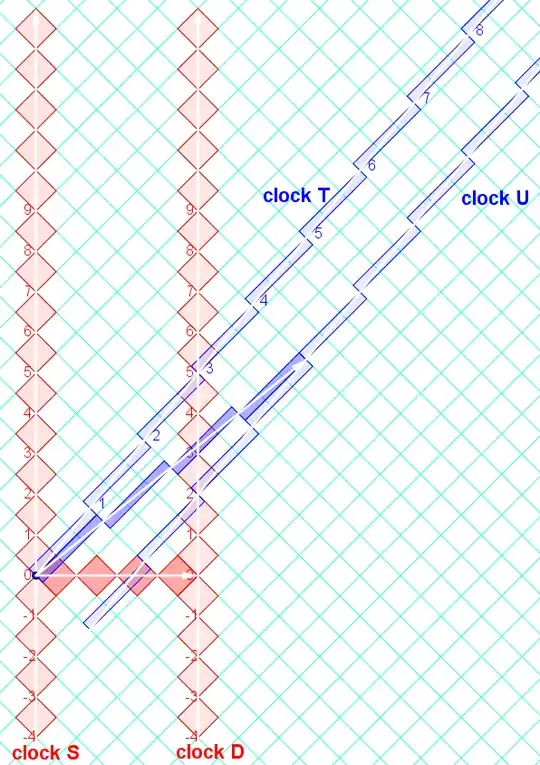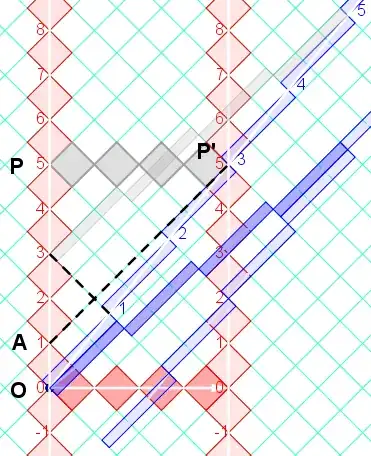A lot of the explanations of the Twin Paradox rely on acceleration, non-inertial frames, and/or curved/kinked world lines to break symmetry and therefore explain why the traveling twin ages less than the stationary twin.
But doesn't the traveling twin, T, age less even if he only flies away in a perfectly straight line with no acceleration, no changes to his inertial frame, and no curved/kinked world line at all?
If that's true, then why can't we put ourselves into T's inertial frame instead and come to the opposite conclusion? T is now stationary and the previously stationary twin, S, is now moving inertially. Can't we reason similarly and assert that S should now age less than T? That seeming contradiction seems to be the crux of the twin paradox for me at least.
So what happens when we cut the Twin Paradox problem in half? Let's eliminate all acceleration, non-inertial frames, and curved/kinked world lines so that they can't possibly be explanations for time passing at different rates for twin clocks.
I want to first demonstrate in S's frame that T really does age less even just with relative inertial motion. So, let's first adopt the inertial frame of clock S.
Clock D is 4 LY distant from S and has zero velocity relative to S. Let's synchronize S and D such that when S = 0, then S also observes distant D = -4 years.
Now suppose another clock T is moving with constant velocity of 0.8c in S's frame towards D. At S = 0, T coincides with S and also happens to have T = 0.
S calculates that T will coincide with D when S = 5 years.
Einstein and Lorentz teach that in T's frame T = 3 years when T coincides with D.
Because clocks S and D are synchronized, in D's frame D = 5 years when T coincides with D.
At T = 0, T sees S = 0 at 0 distance. At T = 3 years, T sees D = 5 years at 0 distance. T knows (was told) that S and D have synchronized time in their frames. Doesn't this mean that T knows S and D have experienced the passage of more time (5 years) than T did during its journey from S to D (3 years)?
Based on this information, can't STD all agree that time actually ran only 60% as fast for T as it did for both S and D during T's journey from S to D?
Here's my question: assuming we can correctly say all of that, then why can't we reformulate the scenario entirely from T's inertial frame and similarly reason that because S and D are moving relative to T, that STD will all agree that S's and D's clocks ran slower than T's?
We can also analyze this situation from what each clock observes during the journey if that helps. Let's say that all the clocks are continuously radio broadcasting their values from long before S and T coincide to long after T and D coincide.
Let's first describe what S observes about D and T.
At S = 0, S observes D = -4 years and T fly through with T = 0 at distance 0. As T flies away from S, S observes that T's clock is running 3 times slower than itself.
At S = 9 years, S observes D = 5 years and T = 3 years at a distance of 4 LY.
At S = x years (s.t. x >= 0), S observes D = x - 4 years and T = x/3 years at a distance of x * 4 / 9 LY.
Now, let's describe what D observes about S and T.
At D = 4 years, D observes S = 0 and T = 0 at a distance of 4 LY. As T flies towards D, D observes that T's clock is running 3 times faster than itself.
At D = 5 years, D observes S = 1 years and T = 3 years at a distance of 0.
At D = x years (s.t. x <= 5 years), D observes S = x - 4 years and T = 3x - 12 years at a distance of 20 - 4x LY.
At D = 0 years, D observes S = -4 years and T = -12 years at a distance of 20 LY.
Interestingly, T appears to D to be traveling at 4 times the speed of light (i.e. - traveling 4 LY in 1 year of D's time). Of course, that's not what is actually happening. As T approaches the speed of light, then T will appear to D to cover more and more distance per unit of D's time. At the limit, T will appear to be moving with infinite speed towards D. This is just a consequence of T chasing the speed of light towards D and, therefore, compressing the information about its position into less and less of D's passage of time. If a distant cataclysmic event is moving towards us at the speed of light, then it will run through us before we can even detect its existence.
Finally, let's describe what T observes about S and D. I might get this part wrong.
At T = 0, T observes S = 0 at distance 0 and D = -4 years at distance 2.4 LY.
At T = 3 years, T observes S = 1 years at distance 2.4 LY and D = 5 years at distance 0.
In T's frame, T observes S's clock to run 3 times slower and observes D's clock to run 3 times faster than T's clock.
All of this demonstrates the seeming "paradox" that both S and T observe each others' clocks running 3 times slower than their own as they move away from each other, but when they make a direct comparison of their clocks at distance 0 (via D's synchronized clock) they all agree that less time has passed for T than S.
Is that the (half) twin paradox explained without invoking any kind of acceleration, non-inertial frames, and/or curved/kinked world lines???
I still don't fully see how this answers my original question though. Can't we reformulate the scenario entirely from T's frame and reason similarly that the now moving clocks S and D should actually run slower (i.e. - via direct comparison of T and D at distance 0)?
The scenarios seem to be the same in the sense that T and D are moving towards one another in both frames, so they will each see the other's clock running 3 times faster than their own clock. Similarly, both S and T are moving away from one another in both frames, so they will each see the other's clock running 3 times slower than their own clock.
Here's a shot in the dark: Is the asymmetry entirely due to the Lorentz length contraction in T's frame while the passage of time in SD's frame is not affected?
EDIT: Thank you all for the kind feedback! Here are a few things I learned through your answers and comments:
- Yes, you can flip my example around and come to the opposite conclusion. STD all agree that less time passed for T in S's frame. STD also all agree that more time passed for T in T's frame. That's symmetric relativistic time dilation.
- The answer to the Twin Paradox really is curved/kinked world lines for the traveling twin breaking relativistic symmetry. This can also be described as acceleration, non-inertial frames, and/or frame switching for the traveling twin.
- You can cut the Twin Paradox in half, somewhat like I supposed, simply by making T match D's velocity when they coincide. That will put T in S's (and D's) inertial frame and the traveler really will have only aged 3 years while S and D have aged 5 years. T's world line will then have a kink in it in all frames. People might argue that example is less tricky and complex than the original Twin Paradox. That's probably true, but the answer to both versions is the same.
- I was implicitly preferring S's frame and using it as my "yardstick." T's frame is every bit as valid and deserved a deeper evaluation of events from T's perspective. The main thing I was goofing up is how the passage of time / simultaneity works in T's frame.

